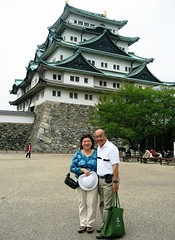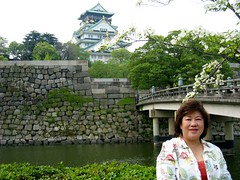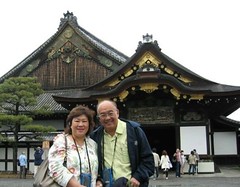Najoya-jo ( 24 Apr 2007). There used to be many castles in Japan. However when the Tokugawa family took absolute power in 17 century, they destroyed many castles in order to reduce the influence of local warlords and to exert central government under the Shogun. Similarly the same tactics were used during the Meiji restoration. The few castles that remained were destroyed during World War II and are now at various stages of restoration. Nagoya castle was one such castle, built by a Ieyasu Tokug awa in 1612 and occupied by a branch of the Tokugawa family, the Owari clan. The founder of the clan was Tokugawa Yoshinao. Two mythical golden dolphin-fish figures topped the castle. They were now fondly referred to as Shachi and had become the symbols for city of Nagoya. The male and female dolphins (kinshachi) weighed about 44 kg each.
awa in 1612 and occupied by a branch of the Tokugawa family, the Owari clan. The founder of the clan was Tokugawa Yoshinao. Two mythical golden dolphin-fish figures topped the castle. They were now fondly referred to as Shachi and had become the symbols for city of Nagoya. The male and female dolphins (kinshachi) weighed about 44 kg each.
 awa in 1612 and occupied by a branch of the Tokugawa family, the Owari clan. The founder of the clan was Tokugawa Yoshinao. Two mythical golden dolphin-fish figures topped the castle. They were now fondly referred to as Shachi and had become the symbols for city of Nagoya. The male and female dolphins (kinshachi) weighed about 44 kg each.
awa in 1612 and occupied by a branch of the Tokugawa family, the Owari clan. The founder of the clan was Tokugawa Yoshinao. Two mythical golden dolphin-fish figures topped the castle. They were now fondly referred to as Shachi and had become the symbols for city of Nagoya. The male and female dolphins (kinshachi) weighed about 44 kg each.
Osaka Castle (28 Apr 2007). The Castle in Osaka was more imposing. It was built by the first warlord that unified Japan, Hideyoshi Toyotomi. However his dynasty did not outlast him, the family was wiped out by the Tokugawas in a very tragic siege of Osaka castle in 1615. There was a Japanese folding screen illustrating the Summer War in Osaka depicting both the victory and the ensuing massacre.  The style of most Japanese castles was the same. The innermost sanctuary was the 4 or 5 tiered tower. The number of tiers one could build was dependent on rank and status. The Osaka castle was surrounded by 3 moats, behind each were 2 metres thick stone walls, 20 to 30 feet high. Between the walls were the “killing” grounds in which gardens were now landscaped. The castle proper rested on a solid stone foundation several metres high.
The style of most Japanese castles was the same. The innermost sanctuary was the 4 or 5 tiered tower. The number of tiers one could build was dependent on rank and status. The Osaka castle was surrounded by 3 moats, behind each were 2 metres thick stone walls, 20 to 30 feet high. Between the walls were the “killing” grounds in which gardens were now landscaped. The castle proper rested on a solid stone foundation several metres high.  Within the last fortress would be a palace where living quarters and reception rooms were found. Japanese castles celebrated the samurai with exhibitions of their armour, swords and weapons. The samurai armour and face masks reminded us of the Dearth Vader face mask of Star Wars.
Within the last fortress would be a palace where living quarters and reception rooms were found. Japanese castles celebrated the samurai with exhibitions of their armour, swords and weapons. The samurai armour and face masks reminded us of the Dearth Vader face mask of Star Wars.
 The style of most Japanese castles was the same. The innermost sanctuary was the 4 or 5 tiered tower. The number of tiers one could build was dependent on rank and status. The Osaka castle was surrounded by 3 moats, behind each were 2 metres thick stone walls, 20 to 30 feet high. Between the walls were the “killing” grounds in which gardens were now landscaped. The castle proper rested on a solid stone foundation several metres high.
The style of most Japanese castles was the same. The innermost sanctuary was the 4 or 5 tiered tower. The number of tiers one could build was dependent on rank and status. The Osaka castle was surrounded by 3 moats, behind each were 2 metres thick stone walls, 20 to 30 feet high. Between the walls were the “killing” grounds in which gardens were now landscaped. The castle proper rested on a solid stone foundation several metres high.  Within the last fortress would be a palace where living quarters and reception rooms were found. Japanese castles celebrated the samurai with exhibitions of their armour, swords and weapons. The samurai armour and face masks reminded us of the Dearth Vader face mask of Star Wars.
Within the last fortress would be a palace where living quarters and reception rooms were found. Japanese castles celebrated the samurai with exhibitions of their armour, swords and weapons. The samurai armour and face masks reminded us of the Dearth Vader face mask of Star Wars.
Nijo Castle(1 May 2007) contained two palaces within its premises, the Ninomaru and the Honmaru, built as the official residence of the Tokugawa Shoguns by the first Shogun, Tokugawa Iyeshu in 1603. Within the Ninomaru Palace, the tourist was guided through the various formal reception rooms and living quarters of high ranking aristocrats during the Edo period in which the warlords led by the Shogun overshadowed the imperial family. The rooms were separated by wooden sliding doors of cypress wood and painted by the great artists of the day. Sliding door panel art were to Japan what frescoes were to the Italians. The sliding doors (fusuma) in the Ninomaru palace were painted by the Kano school especially young Kano Tangyu and Kano Nonobu. The Kano School was a painting family lasting four generations until the Meiji restoration. We were very fortunate to be able to view a special exhibition of the original fusuma panels in celebration of the castle’s 400th anniversary.



No comments:
Post a Comment